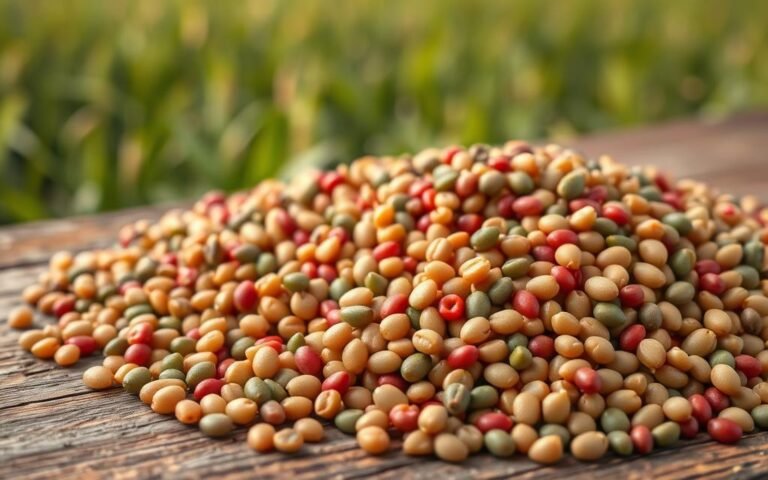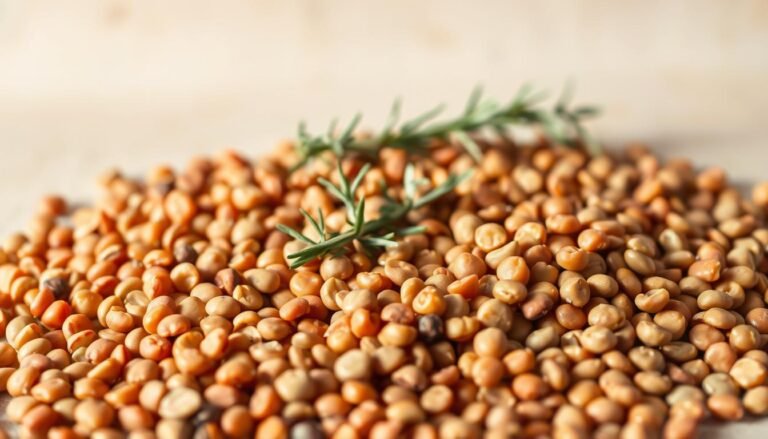Maintaining a healthy heart is crucial for overall well-being, and incorporating heart-friendly foods into your diet is a great place to start. Lentils are rich in nutrients and have been shown to improve cardiovascular health by reducing blood pressure and cholesterol levels.
These small, versatile legumes can be easily added to a variety of dishes, from soups to salads, making them a simple and effective way to protect your cardiovascular system. By including lentils in your meal plan, you can take a significant step towards a healthier lifestyle.
Key Takeaways
- Incorporating lentils into your diet can help reduce blood pressure.
- Lentils are rich in nutrients that support overall cardiovascular health.
- Adding lentils to meals is simple and versatile.
- A diet rich in lentils can help lower cholesterol levels.
- Lentils are a great addition to a heart-healthy lifestyle.
The Silent Epidemic: Understanding Cardiovascular Disease in Australia
Australia faces a silent epidemic with cardiovascular disease being a leading cause of death nationwide. Cardiovascular disease encompasses a range of conditions that affect the heart and blood vessels, often leading to heart attacks, strokes, and other cardiovascular events. Understanding the prevalence and risk factors associated with heart disease is crucial for developing effective prevention and management strategies.
Current Heart Disease Statistics in Australia
Heart disease statistics in Australia are sobering. According to recent data, cardiovascular disease accounts for a significant proportion of deaths, highlighting the need for continued public health efforts to mitigate this risk. The Australian Institute of Health and Welfare reports that heart disease remains one of the top causes of mortality, emphasizing the importance of preventive measures.
Key statistics include:
- Cardiovascular disease is responsible for approximately 45% of all deaths in Australia.
- Heart disease affects a wide demographic, with certain populations being more at risk due to factors like diet, lifestyle, and genetics.
Risk Factors for Heart Disease Among Australians
Several risk factors contribute to the high prevalence of heart disease among Australians. These include dietary habits, physical inactivity, smoking, and high blood pressure. Understanding these risk factors is essential for individuals to make informed lifestyle choices that can significantly reduce their risk of developing heart disease.
Major risk factors include:
- Poor diet, particularly one high in saturated fats, salt, and sugar.
- Physical inactivity, which can lead to obesity and other cardiovascular risk factors.
- Smoking, a well-established risk factor for heart disease.
- High blood pressure, often linked to diet and lifestyle.
The Heart-Diet Connection: How Food Choices Impact Cardiovascular Health
Understanding how dietary choices impact heart health is essential for preventing cardiovascular disease. The food we consume plays a significant role in determining our risk of developing heart disease, making it crucial to make informed choices about our diet.
The Role of Diet in Heart Disease Prevention
A diet rich in fruits, vegetables, whole grains, and legumes like lentils can significantly reduce the risk of heart disease. According to the Mayo Clinic, a heart-healthy diet can help lower blood pressure and cholesterol levels, both of which are risk factors for heart disease. By incorporating a variety of heart-healthy foods into our diet, we can take a proactive approach to protecting our cardiovascular health.
Key Nutrients for Heart Health
Certain nutrients are particularly beneficial for heart health, including omega-3 fatty acids, fiber, and antioxidants. Lentils are an excellent source of these nutrients, making them a valuable addition to a heart-healthy diet. Omega-3 fatty acids help reduce inflammation, while fiber can aid in lowering cholesterol levels. Antioxidants, found in a variety of fruits and vegetables, help protect against oxidative stress, which can contribute to the development of heart disease.
Lentils: The Humble Superfood for Your Heart
With their impressive nutritional profile, lentils are gaining recognition as a heart-healthy food choice. Lentils are packed with nutrients that are essential for maintaining a healthy cardiovascular system.
Nutritional Profile of Lentils
Lentils are a rich source of dietary fiber, protein, and various minerals. They contain both soluble and insoluble fiber, which plays a crucial role in heart health. A single cup of cooked lentils provides about 16 grams of fiber and 18 grams of protein.
- High in fiber, which helps lower cholesterol levels
- Rich in protein, supporting heart health
- Good source of minerals like potassium and iron
Why Lentils Stand Out Among Legumes
Lentils are particularly noteworthy among legumes due to their high nutrient density and low fat content. Unlike some other legumes, lentils are quick to cook and have a mild flavor, making them versatile for various dishes.
The unique combination of nutrients in lentils makes them an excellent choice for those looking to improve their heart health through diet.
Essential Lentils for Heart Health Tips: Expert Recommendations
Incorporating lentils into your diet can be a game-changer for heart health, backed by expert recommendations. Lentils are rich in nutrients that support cardiovascular well-being, making them an ideal food for Australians looking to improve their heart health.
Research-Backed Strategies for Heart Protection
Research has shown that lentils can play a crucial role in heart protection due to their high content of fiber, potassium, and antioxidants. Here are some key strategies for incorporating lentils into your heart-healthy diet:
- Consume lentils at least twice a week to reap their cardiovascular benefits.
- Combine lentils with other heart-healthy foods like vegetables and whole grains.
- Experiment with different types of lentils to vary your nutrient intake.
By following these strategies, Australians can significantly improve their heart health and reduce the risk of cardiovascular disease.
Australian Dietary Guidelines and Lentils
The Australian Dietary Guidelines recommend increasing the intake of legumes, including lentils, for overall health and wellbeing. Lentils are particularly beneficial due to their high fiber and protein content, making them an excellent choice for Australians looking to adopt a healthier diet. Here are some key points from the guidelines:
- Include a variety of legumes in your diet, such as lentils, chickpeas, and beans.
- Aim to consume 75g of legumes per day as part of a balanced diet.
- Choose whole lentils over processed lentil products to maximize nutritional benefits.

By incorporating lentils into your diet in line with these guidelines, you can take a significant step towards protecting your heart health and overall wellbeing.
Fiber Champions: How Lentils Lower Cholesterol Levels
Soluble fiber, abundant in lentils, plays a crucial role in cholesterol management and heart health. Lentils are a rich source of this beneficial fiber, making them an excellent dietary choice for those looking to lower their cholesterol levels.
Soluble Fiber and Cholesterol Management
The soluble fiber in lentils helps to lower LDL (bad) cholesterol by binding to bile acids and removing them from the body, which in turn reduces the amount of cholesterol produced in the liver. This process contributes to improved overall heart health.
Benefits of Soluble Fiber:
- Reduces LDL cholesterol levels
- Helps remove bile acids from the body
- Contributes to a lower risk of heart disease
Recommended Daily Intake for Heart Benefits
To reap the heart benefits of lentils, it’s essential to consume them regularly. The recommended daily intake varies, but incorporating about 1 cup of cooked lentils into your diet can be beneficial.
| Daily Lentil Intake | Cholesterol Reduction |
|---|---|
| 1/2 cup cooked | 5-10% reduction |
| 1 cup cooked | 10-15% reduction |
Including lentils in your daily meals can be a simple yet effective way to manage cholesterol levels and promote heart health.
Blood Pressure Management: Lentils as a Natural Solution
Managing blood pressure is crucial for maintaining overall cardiovascular health, and lentils can play a significant role in this process. High blood pressure, or hypertension, is a major risk factor for heart disease, stroke, and kidney disease. Fortunately, dietary changes, including the incorporation of lentils, can help mitigate this risk.
Potassium, Magnesium, and Blood Pressure Regulation
Lentils are rich in potassium and magnesium, two minerals that are crucial for blood pressure regulation. Potassium helps balance the effects of sodium in the body and promotes blood vessel relaxation, while magnesium supports the proper functioning of blood vessels and helps regulate blood pressure. A diet rich in these minerals can help lower blood pressure in people with hypertension.
Incorporating Lentils for Hypertension Management
Incorporating lentils into your diet can be a simple and effective way to help manage hypertension. Here are some tips:
- Add lentils to soups and stews for a nutrient boost.
- Use lentils as a base for salads or as a protein substitute in dishes.
- Experiment with different types of lentils, such as green, brown, or red lentils, to vary your meals.
By making lentils a regular part of your diet, you can harness their nutritional benefits to support your cardiovascular health.
Weight Management Benefits of Lentils for Cardiovascular Health
Lentils are a nutritional powerhouse that can aid in weight management, thereby supporting heart health. Their unique combination of low calories, high fiber, and protein makes them an ideal food for those looking to manage their weight.
Lentils’ Role in Satiety and Weight Control
Lentils are highly satiating due to their high fiber and protein content. This means that including lentils in meals can help individuals feel fuller for longer, reducing the likelihood of overeating and supporting weight loss efforts. Studies have shown that diets high in fiber and protein can lead to greater weight loss and improved weight management.
Low-Calorie, High-Nutrition Profile
Lentils offer a low-calorie alternative to other protein sources, making them an excellent choice for those managing their weight. One cup of cooked lentils contains approximately 230 calories, along with a rich mix of nutrients including iron, potassium, and folate. This nutrient-dense profile supports overall health while keeping calorie intake in check.
By incorporating lentils into their diet, individuals can enjoy a filling, nutritious meal that supports both weight management and cardiovascular health. The versatility of lentils allows them to be easily added to a variety of dishes, from soups and stews to salads and curries.
Antioxidant Power: How Lentils Fight Inflammation and Oxidative Stress
Rich in antioxidants, lentils offer a natural way to combat oxidative stress and promote cardiovascular well-being. Antioxidants play a crucial role in neutralizing free radicals, which can cause damage to cells and contribute to the development of heart disease.
Key Antioxidants in Lentils
Lentils contain a variety of antioxidants, including polyphenols, flavonoids, and carotenoids. These compounds have been shown to have potent antioxidant activity, helping to protect against oxidative stress. Polyphenols, in particular, are abundant in lentils and have been linked to improved heart health.
| Antioxidant | Function |
|---|---|
| Polyphenols | Neutralize free radicals, reduce oxidative stress |
| Flavonoids | Improve cardiovascular health, anti-inflammatory effects |
| Carotenoids | Antioxidant properties, support overall health |
Anti-inflammatory Effects on Cardiovascular System
The antioxidants in lentils have anti-inflammatory effects that can benefit the cardiovascular system. Chronic inflammation is a known risk factor for heart disease, and consuming foods rich in antioxidants like lentils can help mitigate this risk. As noted by a study, “Diets rich in antioxidant-containing foods like lentils can reduce inflammation and improve cardiovascular health.”
“A diet rich in fruits, vegetables, and legumes like lentils can help reduce the risk of heart disease by combating oxidative stress and inflammation.”

Incorporating lentils into your diet can be a simple yet effective way to boost your antioxidant intake and support heart health. With their rich antioxidant profile and anti-inflammatory effects, lentils are an excellent addition to a heart-healthy diet.
Types of Lentils Available in Australia and Their Unique Heart Benefits
The Australian market boasts a variety of lentils, including brown, green, red, yellow, black, and specialty lentils, each with unique heart benefits. This diversity allows consumers to mix and match lentil types to maximize their nutritional intake and support heart health.
Brown, Green, and French Lentils
Brown, green, and French lentils are among the most commonly consumed types in Australia. Brown lentils are rich in fiber and protein, making them an excellent choice for heart health. Green lentils have a slightly peppery flavor and hold their shape well when cooked, providing a good source of potassium, which is crucial for blood pressure management. French lentils, also known as Puy lentils, are known for their dark blue-green color and earthy flavor, offering high levels of antioxidants that help combat oxidative stress.
| Lentil Type | Nutritional Benefits |
|---|---|
| Brown Lentils | High in fiber and protein |
| Green Lentils | Rich in potassium |
| French Lentils | High in antioxidants |
Red and Yellow Lentils
Red lentils are known for their bright orange-red color and soft texture when cooked. They are rich in fiber, protein, and various minerals, making them beneficial for heart health. Yellow lentils are similar to red lentils in nutritional profile but have a slightly different taste and texture. Both red and yellow lentils are effective in lowering cholesterol levels and managing blood pressure.
Black and Specialty Lentils
Black lentils, also known as Beluga lentils, have a shiny black appearance and a robust flavor. They are rich in anthocyanins, which are powerful antioxidants. Specialty lentils, such as red pardina lentils, offer unique flavors and textures, and are rich in nutrients that support overall heart health.
Incorporating a variety of these lentils into one’s diet can provide a broad spectrum of nutrients and maximize heart health benefits. Australians can enjoy lentils in a range of dishes, from soups and stews to salads and curries, making it easy to support cardiovascular health through diet.
Practical Lentil Preparation Tips for Maximum Heart Benefits
To maximize the heart benefits of lentils, proper preparation is key. Lentils are a rich source of nutrients that support cardiovascular health, but their benefits can be enhanced or diminished based on how they are cooked and prepared.
Soaking and Cooking Methods
Soaking lentils before cooking can significantly reduce their cooking time and improve digestibility. Rinsing lentils thoroughly before soaking can help remove any impurities or debris that may be present. For cooking, using a ratio of 2 cups of water or broth for every 1 cup of lentils is recommended. Bringing the liquid to a boil, then reducing the heat to a simmer, allows the lentils to cook evenly.
Cooking Methods Comparison
| Cooking Method | Cooking Time | Nutrient Retention |
|---|---|---|
| Stovetop | 20-30 minutes | High |
| Pressure Cooker | 5-10 minutes | Very High |
| Slow Cooker | 1-2 hours | High |
Preserving Nutrients During Preparation
To preserve the nutrients in lentils, it’s essential to avoid overcooking them. Lentils are rich in water-soluble vitamins like vitamin B and C, which can be lost in the cooking water if it’s not used as part of the dish. Using the cooking liquid in soups or stews can help retain these nutrients. Additionally, minimizing the use of salt and avoiding high heat can help preserve the nutritional integrity of lentils.
For more detailed information on the nutritional benefits of lentils, visit Healthline’s article on lentils.
7 Simple Ways to Add More Lentils to Your Daily Diet
Lentils are a versatile ingredient that can be added to a variety of dishes for enhanced nutrition. They can easily be incorporated into your daily meals, providing a boost to your heart health and overall well-being.
Breakfast Ideas with Lentils
Starting your day with lentils can be both nutritious and delicious. Try adding cooked lentils to your breakfast omelette or scramble for an extra dose of protein and fiber. You can also blend lentils into your morning smoothie for a nutrient-packed start.
Another innovative breakfast idea is lentil pancakes or waffles, made by incorporating cooked lentils into your batter. This not only adds nutrition but also creates a delightful texture.
Lunch and Dinner Incorporation Strategies
Lentils can be a fantastic addition to your lunch and dinner recipes. For a hearty and healthy meal, consider making a lentil soup or stew. You can also add lentils to your salads, pasta dishes, or curries for an extra nutritional boost.
Using lentils as a base for veggie burgers or as a filling in vegetarian wraps are other great ways to incorporate them into your meals. Lentil-based dips like hummus can be served as a healthy snack or side dish.
Snacks and Side Dishes
Lentils can be used to make a variety of tasty snacks and side dishes. Roasted lentil snacks seasoned with herbs and spices make for a crunchy and healthy treat. You can also prepare lentil patties or fritters as a satisfying snack.
As a side dish, lentils can be cooked with a variety of spices and herbs to complement your main course. A simple lentil salad with mixed vegetables and a light vinaigrette dressing is another refreshing option.
By incorporating lentils into your diet in these simple ways, you can significantly enhance your nutritional intake and support your heart health. Experiment with different lentil recipes to find your favorites and make mealtime both enjoyable and healthy.
Heart-Healthy Lentil Recipes for Australian Kitchens
Lentils are a versatile ingredient that can be used in a variety of heart-healthy recipes. They are rich in nutrients, fiber, and protein, making them an excellent addition to a cardiovascular-friendly diet. In Australian kitchens, lentils can be incorporated into traditional and modern dishes alike, offering a delicious way to protect heart health.
Mediterranean-Inspired Lentil Dishes
Mediterranean cuisine is renowned for its heart-healthy benefits, and lentils play a significant role. A classic Mediterranean Lentil Salad can be made with lentils, diced tomatoes, cucumbers, red onions, and a drizzle of olive oil. Another option is Lentil Stew with spinach and feta, served with whole grain bread.
- Lentil and Vegetable Stew
- Lentil Salad with Feta and Olives
- Stuffed Bell Peppers with Lentil and Rice Mix
Australian Fusion Lentil Recipes
Australian cuisine, with its multicultural influences, offers a unique platform for fusion recipes. Try a Lentil and Barley Soup with a hint of bush tomato, or Lentil and Chicken Shawarma wraps with tzatziki sauce. These dishes blend traditional Australian flavors with international twists.
“The use of lentils in modern Australian cooking not only adds nutritional value but also brings a delightful twist to traditional recipes.” – Chef’s Insight
Quick and Easy Lentil Meals
For busy Australians, quick and nutritious meals are essential. Lentil Curry can be prepared in under 30 minutes and served with brown rice or whole wheat naan. Another quick option is a Lentil and Vegetable Stir-Fry with a sprinkle of turmeric and cumin.
By incorporating these lentil recipes into your diet, you can enjoy a variety of flavors while supporting heart health. Experiment with different ingredients and spices to create your own unique lentil dishes.
Combining Lentils with Other Heart-Protective Australian Foods
To maximize the cardiovascular benefits of lentils, it’s essential to pair them with other nutrient-rich foods commonly found in Australian cuisine. This approach not only enhances the nutritional value of meals but also contributes to a well-rounded diet that supports heart health.
Synergistic Food Combinations
Combining lentils with other heart-healthy foods creates synergistic effects that can significantly boost cardiovascular well-being. For instance, pairing lentils with leafy greens like spinach provides a powerful mix of fiber, protein, and antioxidants. Similarly, combining lentils with fatty fish rich in omega-3 fatty acids, such as salmon, can enhance their anti-inflammatory properties. Other beneficial combinations include lentils with whole grains like quinoa or brown rice, and with vegetables high in vitamins and minerals, such as carrots and bell peppers.
Creating Balanced Heart-Healthy Meals
To create balanced heart-healthy meals, it’s crucial to consider the overall nutritional profile. A well-structured meal should include a mix of protein, healthy fats, and complex carbohydrates. For example, a hearty lentil soup made with vegetable broth, onions, garlic, and a variety of vegetables, served with a side of whole-grain bread and a green salad dressed with olive oil, provides a balanced and satisfying meal. By incorporating a variety of heart-healthy foods and being mindful of portion sizes, individuals can enjoy delicious and nutritious meals that support their cardiovascular health.
Potential Considerations: When to Moderate Lentil Consumption
Lentils are generally a healthy choice, but certain individuals may need to moderate their intake. While lentils offer numerous health benefits, there are potential considerations to be aware of, particularly regarding digestive concerns and interactions with medications.
Digestive Concerns and Solutions
Some people may experience digestive issues such as bloating or gas when consuming lentils. To mitigate these effects, it’s recommended to start with small portions and gradually increase the amount. Soaking lentils before cooking can also help reduce digestive discomfort. Additionally, cooking lentils thoroughly can make them easier to digest.
Interactions with Medications and Medical Conditions
Individuals on certain medications or with specific medical conditions should be cautious when consuming lentils. For instance, lentils are high in fiber, which can interact with medications for diabetes or blood thinners. People with kidney issues may need to limit their intake of high-potassium foods like lentils. It’s advisable to consult with a healthcare provider or a registered dietitian to determine the best approach for individual needs.
By being aware of these potential considerations and taking steps to manage them, individuals can continue to enjoy the heart health benefits of lentils while minimizing any adverse effects.
Sustainable Heart Health: Building Long-Term Habits with Lentils
Incorporating lentils into your daily meals can significantly boost your cardiovascular well-being over time. By making lentils a staple in your diet, you’re taking a proactive step towards a healthier heart. This approach not only nourishes your body but also fosters a sustainable lifestyle that can lead to long-term heart health benefits.
Creating a Sustainable Heart-Healthy Lifestyle
To create a sustainable heart-healthy lifestyle, start by incorporating lentils into your meal planning. Begin with simple recipes like lentil soups or salads. Gradually, you can explore more complex dishes like lentil curries or stews. The key is consistency and variety. By making lentils a regular part of your diet, you’ll be more likely to maintain a heart-healthy lifestyle in the long term.
Tracking Progress and Health Improvements
Tracking your progress is crucial when adopting a new diet. Keep a food diary to monitor your lentil consumption and note any changes in your overall health. Regular check-ups with your healthcare provider can also help track improvements in your cardiovascular health. By being mindful of your progress, you’ll be motivated to continue your heart-healthy habits, leading to sustainable heart health and overall well-being.
Conclusion: Embracing Lentils for a Healthier Heart and Longer Life
Incorporating lentils into your diet can be a simple yet effective way to protect your cardiovascular system. The cumulative evidence supports the inclusion of lentils in a diet aimed at improving heart health and longevity.
Lentils for heart health offer numerous benefits, from lowering cholesterol levels to managing blood pressure. By making lentils a staple in your diet, you can take a significant step towards a healthier heart.
As you explore the world of lentils, you’ll discover a variety of delicious and nutritious options to add to your meals. By combining lentils with other heart-protective foods and maintaining a balanced lifestyle, you can significantly reduce your risk of cardiovascular disease.
Embracing lentils as part of a healthier lifestyle can lead to a longer, healthier life. Start incorporating these nutritious legumes into your diet today and take the first step towards a healthier heart.





